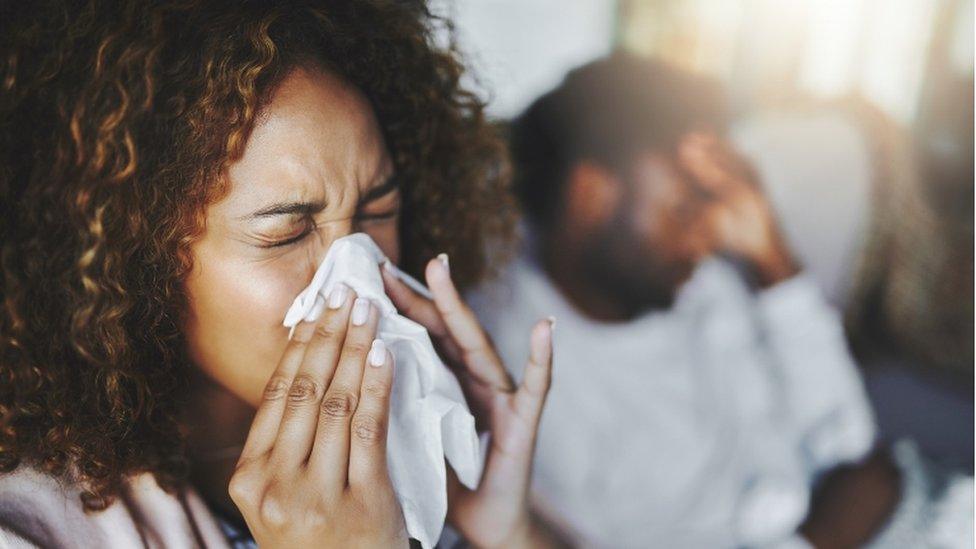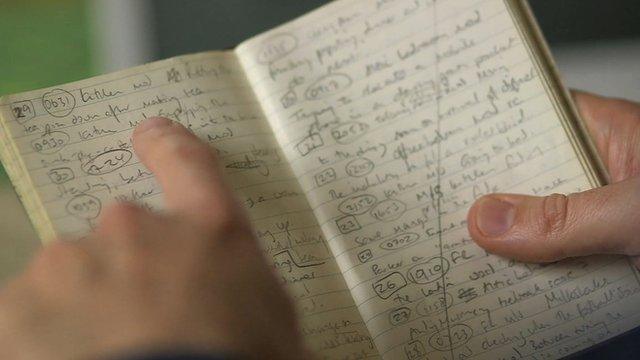Should you leave the room when you cough or sneeze?
- Published

US President Donald Trump set off conversations on cough etiquette after it emerged he asked an aide to leave the Oval Office for coughing during an interview. Plenty of people shared his irritation - so what is the right thing to do?
"If you're going to cough, please leave the room," said Mr Trump after Mick Mulvaney, the acting chief of staff, cleared his throat.
"You just can't cough... he's coughing in the middle of my answer. I don't like that."
The online response to the #MulvaneyCough has been mixed, with some joking that it's the first time the divisive president has been relatable, while others say it shows what an insensitive boss he must be.
Though Mr Trump's ire seemed mostly due to the interruption, his distaste for coughing isn't surprising - the president is a self-professed germaphobe.
A 2005 book, The World According to Trump, quoted him as saying, external: "I mean, they have medical reports all the time. Shaking hands, you catch colds, you catch the flu, you catch this. You catch all sorts of things. Who knows what you don't catch?"
But Mr Trump is not the only famous face with a distaste for coughing and sneezing - Vince McMahon, an American pro-wrestling executive, reportedly has a no-sneezing rule , externalaround him.
And Obama-era Health and Human Services Secretary Kathleen Sebelius also once scolded a journalist during a press briefing for not sneezing into his elbow, external, half-jokingly calling for hand sanitiser and a lesson on how to sneeze properly.
So what is the best way to sneeze or cough in a public place?

The etiquette of being ill...
Crystal L Bailey, director of the Etiquette Institute of Washington, says: "The idea is to avoid people as much as possible when you do need to sneeze or cough.
"There was a time when we would have used handkerchiefs, but if there's a tissue available or if you're able to sneeze into your elbow... make sure that happens. That you move yourself and your mouth and face in the opposite direction of anyone else."
If that isn't possible - say, on a crowded train - Ms Bailey advises trying to get to an elbow, not a hand, so you avoid spreading germs on handrails or other surfaces people might touch.

A rendition of the flu virus
But if you do end up sneezing or coughing close to someone else, apologise with an "excuse me". And if you feel a coughing fit coming on in a cinema or theatre, leaving the room is probably best.
Ms Bailey also noted that if you are sick, avoiding handshakes can be a respectable course of action.
"You need to say something and not just decline someone's handshake without giving them an explanation because that's a big faux-pas," she notes. "But I think we would all appreciate not having to shake hands with someone who is sick."
And if someone is not adhering to these rules of engagement, Ms Bailey recommends the gum approach.
"Maybe to offer a tissue, or signalling by yourself using hand sanitiser - it's like [if someone has bad breath] taking a piece of gum yourself and then offering it and hopefully it won't come across too badly."
"Other than that," she notes, "the only behaviour we can truly control is ourselves."
...and the medical reasons to follow it
The best way to limit transmission is to contain it in something that can be thrown away, says Dr Tenagne Haile-Mariam, assistant professor of emergency medicine at George Washington University.
"The best would be a tissue, and whatever you sneeze or cough is contained in that, then crumpled up with the contaminated side in."
Direct contact with a sick person's bodily fluids - droplets or otherwise - is the most common way to catch a cold, but asking someone to leave a room to cough is not "the be all end all" to avoiding contracting their illness, says Dr Haile-Mariam, because "coughing is not the only way to transmit".
The man who records all his sneezes
If they come back into your area and they touch their nose and face, you are no longer protected.
Small particulates, like viruses, can travel a maximum of six feet (1.8m) with a sneeze or cough, while larger droplets generally cannot go more than three feet, she says. But if someone coughs into their hand or an empty space, that matter can land on objects that others might touch.
Most infectious particles do not survive outside the body for very long, but some can, like chicken pox or tuberculosis.

What about other countries?
In India, where tuberculosis is a major health concern, health organisations have launched campaigns to educate people on better coughing etiquette.
South Korea has had similar issues with coughing and tuberculosis; one study found, external just a little over half of Koreans were aware of respiratory hygiene best practices.
A New Zealand study, external during the 2009 swine flu outbreak found only one in four people covered their nose and mouth when coughing or sneezing.
In Japan, wearing surgical masks is common - whether to prevent the spread of germs or lessen allergies by filtering out pollen or for celebrities keep a low-profile. According to Nippon.com, external, the practice began after 1918's deadly Spanish flu pandemic.

But in order to fall sick, there must be a "critical amount" of bacterial or viral particles, she says. "We live in a world full of contaminants [but] your body's pretty good at getting rid of things unless it's overwhelmed."
Dr Haile-Mariam's best advice? Wash your hands, external - even if you aren't sick.
"Because you will touch a surface that someone has coughed or sneezed on or has put something they've coughed or sneezed into on," she says.
"When we're sick we're diligent as good citizens about not wanting to infect other people and we wash our hands and throw our tissues and so on. But if we're not sick we need to be just as diligent about washing our hands."
- Published11 February 2019

- Published8 October 2014

- Published16 January 2018

- Published29 January 2013
